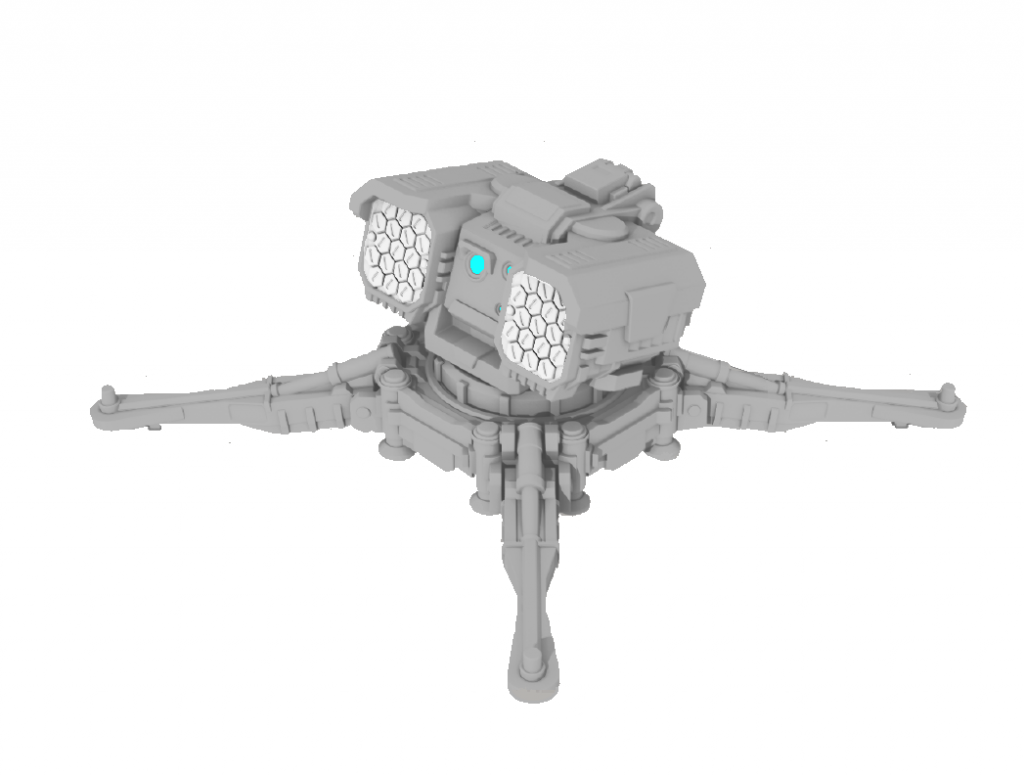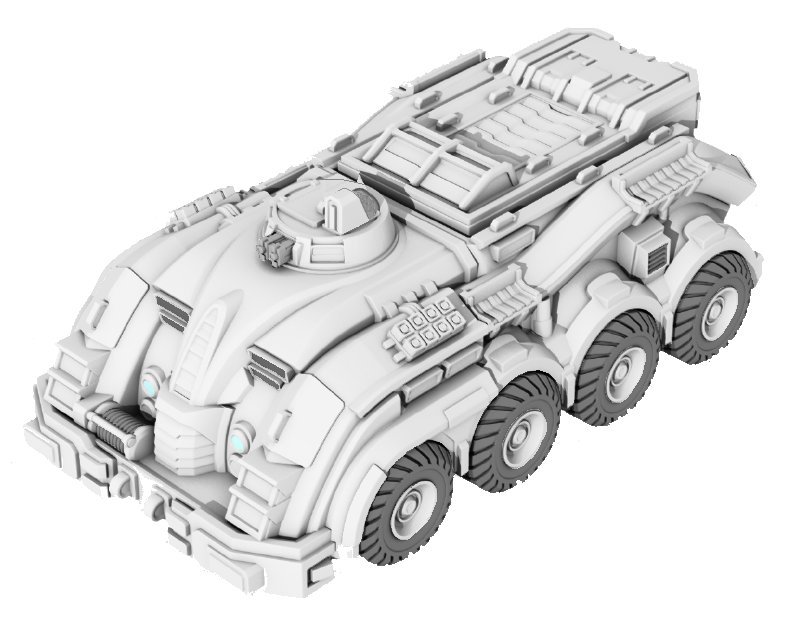Directorate Officer
[member="Jaxon Wyatt"], [member="Kiyron"], [member="Blackhot"] [member="Camellia Swift"]
This is one of the tech counters I was thinking about for the Sithspawn we seem to frequently be facing, those it could be useful for other things as well.

Image Source: I modified an image of Spartan Game's Estock Flechette Launcher emplacement
Intent: To provide an automated static ground defense for Republic troops and facilities
Development Thread: If needed
Manufacturer: Lucerne Labs / Tezmond Solutions
Model: LLT-5 Firewind-class Automated Emplacement
Affiliation: Galactic Republic
Modularity: wrist rockets
Production: Major
Material: droid brain, wrist-rocket launchers, various electrical components, durasteel frame, ferroceramic casing
Classification: 4th
Weight: 60 kilograms
Height: 0.75 meters
Movement: None (cannot under its own power)
Armaments: 2 banks of 20 MM9 Wrist Rocket Launchers (40 tubes total), (120 rockets total)
Misc. Equipment: 1 telescopic photoreceptor, 1 near-range photoreceptor, 1 Infrared sensor, density projector
Strengths:
-Variety of munitions
-Reasonable ammunition capacity
Weaknesses:
-Incapable of moving itself
-rockets are short-ranged (65 to 100 meter maximum dependent on rocket used), easily outranged by standard blaster rifles and carbines
-Can quickly run out of ammunition
LLT-5 Firewind -class Automated Emplacement
Description: A joint project between Lucerne Labs and Tezmond Solutions, the LLT-5 Firewind Automated Emplacement is a relatively small, static battle droid which launches small rockets from the MM9 system, more commonly known as “wrist rockets” from their use by the bounty hunters Jango and Boba Fett. Typically, Firewinds are moved into position by ground squads using the droid's own built-in repulsor pads, (much like SoroSuub's earlier Memory Droids). These pads only negate the droid's weight, and do not provide any means of movement on its own. Once the droid is in position, it lowers its stablizing legs and activates its density projectors to firmly implant itself on the ground, a necessity given the recoil of its weaponry.
On either side of the droid's chassis sit a clusters of twenty MM9 [/url tubes. While each tube can fire a variety of wrist rockets, each cluster may only carry one type of rockets at time. Typically, one cluster carries Type-12 A anti-personnel rockets while the other carries K26 anti vehicle rockets, which are typically only effective against light vehicles such as speeder bikes and landspeeders. But it's not uncommon for other munitions to be carried, such as stun rockets for riots or to capture people, or DEMP rockets for facing other battle droids. Aiming is accomplished by using the droid's two optical sensors (photo-receptors) and infrared sensor, upon which the droid swivels on its turret to face the target and fire.
The droid itself is very simplicistic, with no personality matrix or vocabulator. This is intentional, as the droid was intentionally made very basic in order to keep maintenance cost down and to make the design more rugged for field use. The only thing making the LLT-5 more advanced than a mouse droid is its threat analysis programming, which allows it to determine who and what are morally valid targets, and when to fire upon the target.
Current testing has shown the Firewind to be adequate at temporarily stalling enemy attacks, though clever opponents will often simply stay out of range of the target and destroy it with repeated blaster fire if they can get a line of sight. Otherwise, some opponents will simply avoid it, as the droid cannot move. Still, the Firewind's makers understand those defects, arguing that the Firewind should be employed as supplements to organic troops and other battle droids, not a mere replacement.
This is one of the tech counters I was thinking about for the Sithspawn we seem to frequently be facing, those it could be useful for other things as well.

Image Source: I modified an image of Spartan Game's Estock Flechette Launcher emplacement
Intent: To provide an automated static ground defense for Republic troops and facilities
Development Thread: If needed
Manufacturer: Lucerne Labs / Tezmond Solutions
Model: LLT-5 Firewind-class Automated Emplacement
Affiliation: Galactic Republic
Modularity: wrist rockets
Production: Major
Material: droid brain, wrist-rocket launchers, various electrical components, durasteel frame, ferroceramic casing
Classification: 4th
Weight: 60 kilograms
Height: 0.75 meters
Movement: None (cannot under its own power)
Armaments: 2 banks of 20 MM9 Wrist Rocket Launchers (40 tubes total), (120 rockets total)
Misc. Equipment: 1 telescopic photoreceptor, 1 near-range photoreceptor, 1 Infrared sensor, density projector
Strengths:
-Variety of munitions
-Reasonable ammunition capacity
Weaknesses:
-Incapable of moving itself
-rockets are short-ranged (65 to 100 meter maximum dependent on rocket used), easily outranged by standard blaster rifles and carbines
-Can quickly run out of ammunition
LLT-5 Firewind -class Automated Emplacement
Description: A joint project between Lucerne Labs and Tezmond Solutions, the LLT-5 Firewind Automated Emplacement is a relatively small, static battle droid which launches small rockets from the MM9 system, more commonly known as “wrist rockets” from their use by the bounty hunters Jango and Boba Fett. Typically, Firewinds are moved into position by ground squads using the droid's own built-in repulsor pads, (much like SoroSuub's earlier Memory Droids). These pads only negate the droid's weight, and do not provide any means of movement on its own. Once the droid is in position, it lowers its stablizing legs and activates its density projectors to firmly implant itself on the ground, a necessity given the recoil of its weaponry.
On either side of the droid's chassis sit a clusters of twenty MM9 [/url tubes. While each tube can fire a variety of wrist rockets, each cluster may only carry one type of rockets at time. Typically, one cluster carries Type-12 A anti-personnel rockets while the other carries K26 anti vehicle rockets, which are typically only effective against light vehicles such as speeder bikes and landspeeders. But it's not uncommon for other munitions to be carried, such as stun rockets for riots or to capture people, or DEMP rockets for facing other battle droids. Aiming is accomplished by using the droid's two optical sensors (photo-receptors) and infrared sensor, upon which the droid swivels on its turret to face the target and fire.
The droid itself is very simplicistic, with no personality matrix or vocabulator. This is intentional, as the droid was intentionally made very basic in order to keep maintenance cost down and to make the design more rugged for field use. The only thing making the LLT-5 more advanced than a mouse droid is its threat analysis programming, which allows it to determine who and what are morally valid targets, and when to fire upon the target.
Current testing has shown the Firewind to be adequate at temporarily stalling enemy attacks, though clever opponents will often simply stay out of range of the target and destroy it with repeated blaster fire if they can get a line of sight. Otherwise, some opponents will simply avoid it, as the droid cannot move. Still, the Firewind's makers understand those defects, arguing that the Firewind should be employed as supplements to organic troops and other battle droids, not a mere replacement.






